How To Promote Your Blog: The Definitive 2024 Guide

Want to learn how to promote your blog and get more people reading your content? We’ve got you covered.
In this post, you’ll learn 35 powerful promotional tactics you can use to drive a ton of traffic to your blog posts.
To keep things organized, we’ve grouped the strategies into different marketing channels: SEO, social media, email, and paid ads (plus some bonus strategies that don’t fit into any of the above).
Start off by choosing which channel you want to focus on and go from there.
How to promote your blog through SEO
SEO (search engine optimization) is how most bloggers choose to promote their posts and get people onto their site.
It involves optimizing your content to stand the best chance of ranking in the search engine results pages (SERPs) so that you drive more organic traffic.
Here are some actionable ways you can promote your blog through SEO.
1. Follow on-page SEO best practices
The best way to drive more traffic to your blog is to make sure you optimize every post you publish for search engines, following on-page SEO best practices.

There’s a lot that goes into on-page SEO, and it gets a little complicated. We don’t have time to cover everything here, but some things you should make sure you do for every post you publish include:
- Start with keyword research. You’ll need to write about topics that people are actually searching for in Google & other search engines. These keyword research tools will help.
- Use the target keyword (that’s the search query you hope to rank for) in the blog post URL, title tag, meta description, and first paragraph.
- Cover the topic in-depth.
- Make sure your content aligns with the other posts that are already ranking on Google for the target search query.
- Choose an appropriate word count – around 2,000-3,000 words is often a sweet spot, but it depends on what’s already ranking.
- Make the post as ‘readable’ as possible by separating it up into sub-headings (H2s, H3s, H4s, etc.)
To learn more, read our beginner’s guide to SEO. You might also want to check out our roundup of the best on-page SEO tools.
2. Update your old content
If you’ve been blogging for a while, the chances are you probably have a ton of old posts on your website that you haven’t looked at in forever.
The problem is that Google prefers to rank fresh, new content. So if your posts are old and outdated, they’re probably not ranking as well as they should be.
An easy fix for this is to go back over them and update them to freshen them up.
If any information is outdated, remove it. Give each post a few new images, add some new information, and make sure they’re all optimized around a good target keyword, then republish.
This might be all it takes to trick Google’s algorithm into taking another look at your old posts and pushing them up the search rankings, thus boosting your organic visibility.
Related reading: How To Update Your Old Blog Posts For Maximum Traffic
Bonus tip: If updating all your old content seems too much work, consider using AI writing tools to speed up the process. You can feed them your old posts and enter some prompts to have them rewrite them in a way that adds value, then repost. But don’t rely on AI entirely. You’ll still need to edit the post and fact check everything. Publishing AI content without editorial oversight is a recipe for disaster.
3. Start guest posting on other sites
Guest posting involves reaching out to other blogs/online publications in your niche and asking them if you can write an article to be published on their site.
Typically, you’ll be credited as an author on the post, with a bio link that points back to your blog.
Plus, if the site you’re writing for agrees, you might even be able to directly promote your blog inside the guest post.
Not only is guest blogging a great way to build backlinks (which helps with SEO), but it also gets your blog in front of a brand-new audience.
The hope is that some of the people who read your guest post will decide to check out your blog and become regular readers.
You can use a blogger outreach tool to help you find guest posting opportunities.
Then, send the relevant contacts at each blog an email with your pitch—just make sure you read our guide on how to write outreach emails that don’t suck first.
Related reading: The No-Fail Guide To Guest Blogging Strategy
4. Sign up for HARO
HARO (Help a Reporter Out) is another great tool for promoting your blog.

It’s a service that journalists use to find experts to contribute to the stories they’re working on.
Bloggers can use it to get featured in major publications and news outlets.
It works like this: You sign up as a contributor, and every week, you’ll receive newsletters with dozens of questions and queries from journalists in your email inbox.
Look for questions in your niche, then email the journalists who asked them with thoughtful answers to their questions, alongside your details.
If a journalist decides to use your quote in the article they’re working on, they’ll typically credit you as the source with a link back to your blog.
Their readers might click this link and visit your blog, helping you to reach a larger audience.
Plus, backlinks on major news sites can really help boost your SEO, which also helps you to rank higher and drive more traffic from search.
5. Make the most of internal links
Internal links are links on your website that point to other pages on your website. It’s important to use them effectively.
If your blog is part of a larger brand website/ecommerce store, try linking to it in your main navigation bar. This should help funnel more of your site visitors to it.
Also, each time you publish a new blog post, try including some internal links within it that point to other, related posts on your site.
Not only does this help with SEO, but it also helps improve the user experience, and direct viewers around your site to increase your overall page views.
6. Focus on the right keywords
If you want to successfully drive organic search traffic to your blog, it’s vital to get your keyword strategy right.
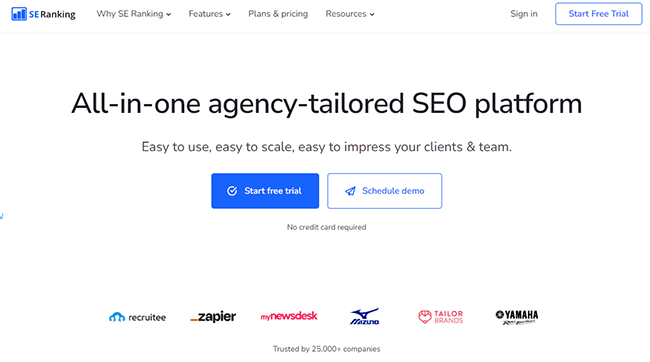
Use keyword research tools like SE Ranking to find relevant keywords that your target audience is searching for.
The best opportunities are those with a high monthly search volume and low competition.
Try to target only those keywords that are relevant to your niche, that are likely to drive traffic, and that you stand a reasonable chance of ranking at the top of the SERPs for.
To analyze keyword competition, you can look at what’s already ranking. If all the posts that are in the top 10 results on Google come from very authoritative websites (with a high DA/DR), and are well-optimized, it might be tough to compete.
But if they’re from websites with a similar domain authority to your own site, and they’re not well-optimized, you might be able to outrank them.
How to promote your blog through social media
SEO isn’t the only way to drive traffic to your blog. Lots of bloggers have had success promoting their posts through social media. Here are some social media marketing strategies you can try.
7. Share new posts on all your social media accounts
Every time you publish a new blog post, share it on all the social media platforms you’re active on.
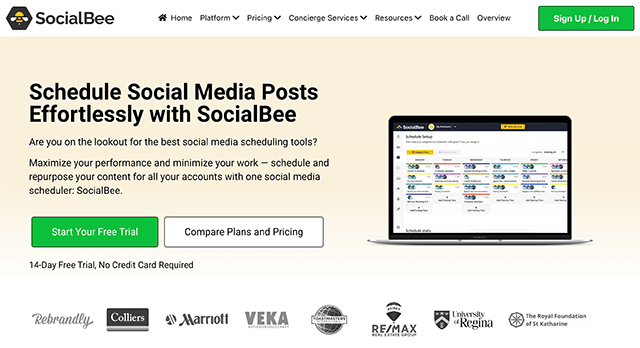
That might include Facebook, Instagram, TikTok, LinkedIn, Pinterest, etc.
It helps if you have a large social following. And the best way to grow your following is to regularly publish awesome, engaging social content.
You can use a social media scheduling tool like SocialBee to plan your calendar, curate social content, and schedule posts months in advance.
Most scheduling tools also come with some sort of RSS feed function that you can use to share your new blog posts on social media sites automatically, so you don’t have to do it manually every time.
8. Use a social share plugin
Aside from sharing blog posts on your own socials, you should also make it easy for your readers to share them.
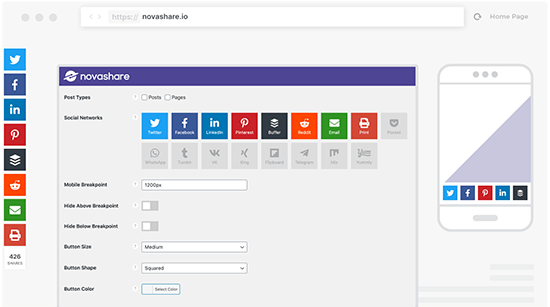
And the best way to do that is to add social share buttons so that anyone can share a link to the post in one click.
If your blog is built on WordPress, you can install and activate a social share plugin to set everything up.
Novashare is a popular option. It’s lightweight and comes with all the features you need.
9. Optimize your posts for social media
When your blog posts get shared on social media, you want to make sure they look as ‘clickable’ as possible, so that more people will click through and visit your site.
Usually, the best way to optimize your posts so they look great on social is by using Open Graph tags to ‘tell’ social media platforms what title, description, and image to use.
There are lots of plugins that can do this automatically for you, like Yoast SEO. You can also add Open Graph tags manually if you’re comfortable adding in a few lines of code.
10. Run a social media contest
Another great way to promote your blog on social media is to run a contest or giveaway.
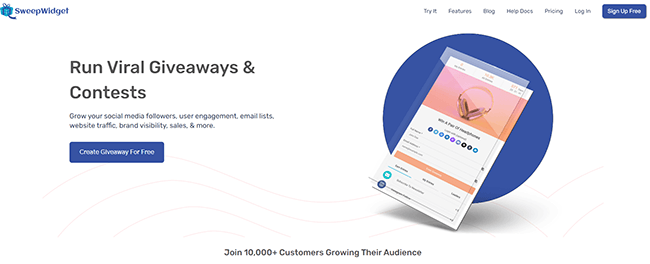
You’ll need to use a social media contest tool like SweepWidget to set it up.
The first step is to choose a prize. This should be something your target audience will want to get their hands on. The better the prize, the better the results.
Next, set your contest entry requirements. As the goal is to promote your blog, one of the entry requirements should be for the entrant to visit your blog website. Alternatively, it might be to like or share a specific blog post.
You can have multiple entry requirements if you want. For example, you could also ask entrants to tag a friend for a bonus entry, which can help your contest go viral and reach more people.
11. Repurpose your blog posts as YouTube videos
You can get more out of your blog content by turning your posts into videos and uploading them to YouTube.
Sharing content on YouTube can help you tap into a huge amount of viewers that you wouldn’t be able to reach through blogging alone, and it also opens up a new revenue channel for you.
You can funnel your YouTube video viewers back to your blog by adding links to your posts in your video descriptions.
And the best part is that repurposing content has never been easier. Thanks to new generative AI tools, you can turn a blog post into a video script in minutes.
Then, you can generate an AI voiceover, grab some visuals to go with it, and put it together in your editing software. With this method, it’s possible to create a YouTube video from a blog post in under an hour.
Read more: What Is Content Repurposing? Definition, Tactics, And Examples
12. Turn your blog posts into podcasts
Aside from YouTube videos, you can also turn your blog posts into podcasts and share them on platforms like Spotify, Apple Podcasts, Google Podcasts, etc.
Again, this is a great way to open up a new revenue channel while also getting your content in front of new viewers.
You can use your podcast to cross-promote your blog by linking to it in the description, and vice-versa.
13. Repost your content on LinkedIn
Everyone’s using Facebook, Instagram, and TikTok to promote their stuff, but far fewer people are using LinkedIn.
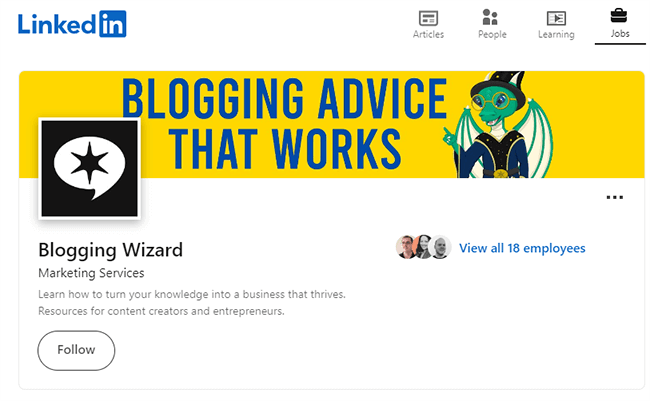
It’s still largely untapped, which is a shame because LinkedIn is one of the best places to promote your blog.
And it’s super simple to do. All you have to do is repost your best blog content there—it’s that easy.
Just copy-paste a post you think people would be interested in over to LinkedIn, and if it’s worth reading, it could get a ton of views. And if people who read it on LinkedIn like it, there’s a good chance they’ll find their way back to your blog and become regular readers.
Bonus tip: If you’re publishing long-form content, don’t publish it in full. Publish part of it on LinkedIn and include a CTA at the bottom of your post encouraging readers to check out the full version on your blog.
14. Promote your blog on Reddit
Reddit is another social platform that marketers are sleeping on.
You can drive a ton of great traffic to your blog from Reddit if you go about it the right way. But it’s a lot harder to do compared to other social platforms.
The reason for that is that most subreddits have strict policies against self-promotion, so you can’t just share links to your blog posts like you can on Facebook, Twitter, etc.
However, you can include a link to your blog in your Reddit profile. Then, engage in relevant subreddits to your niche and become a valuable member of the community. Get that right, and people will naturally find their way to your profile and check out your blog.
There may also be opportunities to outright link to your blog posts in comments on popular threads, etc. but you’ll have to be subtle about it and comply with all the rules of the subreddit.
15. Promote your blog on Quora
Quora is a question-and-answer site where users post questions about anything, and other users answer them, much like Reddit.
And a lot of bloggers have successfully used Quora to promote their posts.
The idea is to find questions about a topic you’ve written a blog post about, and then answer those questions with a link back to your post.
Make sure your answer is well written and well thought out so that it stands the best chance of getting upvoted and appearing at the top of the page.
That way, more of the people who visit the Quora page will see your response and the link to your blog.
If you do this at scale and answer dozens of questions, you can drive thousands of page views. And all of those viewers have the potential to become regular readers.
16. Add your blog content to Quuu Promote
Quuu Promote makes it easy to promote your blog content for almost zero effort
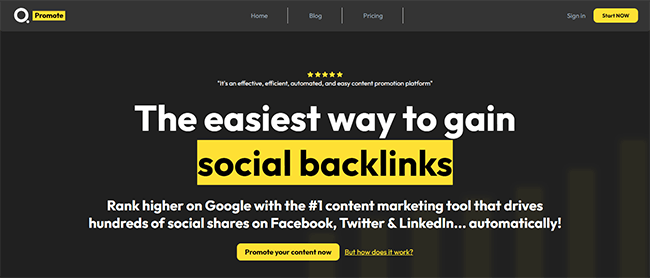
All you have to do is sign up and add your blog posts, and they’ll start getting shared by real influencers in your niche (not bots) across social media.
This can generate a ton of social referral traffic for you. Plus, it also builds social backlinks, which can help you rank higher on Google and get more search traffic.
I know what you’re thinking: That sounds too good to be true; how does Quuu Promote get real people to share your content?
Well, Quuu’s core offering is content curation software for social media marketers and influencers.
They use the platform specifically to find fresh, engaging content to share with their followers.
And once you add your blog posts to Quuu Promote, they start getting served up to these users, who have the option to share them.
The platform users get to fill out their social content calendar with engaging content, and you get free promotion. It’s a win-win.
Read more: 12 Content Promotion Platforms To Increase Your Blog’s Traffic
17. Start a Facebook group
At a minimum, every blogger should have a Facebook page where they share new posts.
But if you want to take it a step further, why not create a Facebook Group too?
Your Facebook Group serves as a central hub where your readers can interact. It’s a great way to build a stronger community around your blog while also serving as another powerful promotional channel.
If Facebook isn’t your thing, but you’d still like to offer a community space for your readers, check out these alternatives to Facebook Groups.
Related reading: 15+ Ways To Grow Your Facebook Group 3x Faster
18. Utilize influencer marketing
If you have the budget for it, you could consider partnering with social media influencers to promote your blog to a wider audience.

You can use an influencer marketing research tool like BuzzStream or ContentStudio to find creators with a large social following in your niche.
Then, make a list of prospects, and send personalized outreach emails to them asking them if they’d be interested in collaborating.
For example, you could have an influencer share one of your posts with their audience in exchange for a fee.
19. Share your posts on Flipboard
Flipboard is part social media platform, part news aggregator.

Users visit it to view curated news stories and articles just for them.
Bloggers can sign up and share, or ‘flip’, their blog posts to Flipboard, so that other users of the app can discover them.
In doing so, you’ll be promoting your blog to the 145 million people who use Flipboard every month and significantly increasing your reach.
How to promote your blog through email
Email is another powerful marketing channel that you can use to promote your blog. Here are some tips to help you get started.
20. Set up an email newsletter
The easiest way to promote your blog through email is to set up a newsletter.

A newsletter is a periodic email that gets sent out to your subscribers at regular intervals (e.g. weekly, bi-weekly, monthly, etc.)
Blog newsletters typically contain a list of all the latest posts you’ve published, and invite readers to check them out.
To get started, you’ll need to sign up for an email newsletter software platform. We’d recommend MailerLite.
It has everything you need including a drag-and-drop newsletter builder, lots of stunning templates, and a super generous free plan.
21. Use opt-in forms to grow your list
There’s no point in having a newsletter if you don’t have any contacts to send it to.
The more contacts in your list, the more traffic you’ll drive through your own blog newsletter.
To get more contacts, you can create an opt-in form inviting users to join your mailing list, and then add it to your website sidebar, footer, etc. or host it on its own landing page.
Most email newsletter tools (including MailerLite) come with features that let you build opt-in forms, so it should be easy enough to set them up.
It’s also important to give people a reason to opt-in to your list. And the best way to do that is to offer some sort of ‘lead magnet’.
Your lead magnet is something valuable that you give to new subscribers for free when they sign up. For example, it might be a free downloadable resource or an exclusive discount for your store.
We offer a library of resources for bloggers. But all you really need is a single downloadable resource. Here’s how one of our signup forms looks:

If you’re using MailerLite, you can use their opt-in form functionality. Alternatively, these email capture tools will help.
Bonus tip: Another great way to build your email list fast is to create an online quiz, and require users to subscribe to your mailing list in order to receive their results. You can use an online quiz maker to set this up.
Related reading: How To Get More Email Subscribers: 37 Strategies You Can Use
22. Segment your list
As you build your list, you can split it up into distinct groups, or ‘segments’.
The idea is to collect data about your contacts to find out who they are, what they’re interested in, etc., and group them accordingly.
Then, you can tailor your newsletter and promotional emails to send targeted content to each segment, which leads to better results.
For example, let’s say you have a blog in the ‘pet’ niche. Some of your readers might be dog owners, and as such, only interested in content about dogs. Others might be cat owners, and only interested in posts about cats.
You can look at their website activity (i.e. which posts they’ve viewed or interacted with) to segment them into ‘dog owners’ and ‘cat owners’.
Then, when you send your newsletter, only include dog-related posts in emails to the former group, and only include cat-related posts in emails to the latter group.
You get the idea.
Again, most email marketing platforms include segmentation capabilities, so it should be easy enough to set this up.
23. Link to your blog in other business emails
Aside from your newsletter, you may also have other automated business emails that you regularly send out, like welcome sequences, order confirmations, etc.
These are all great places to link to your blog content.
For example, if you run an ecommerce store that also has a blog, you could send a thank you email after every purchase with links to some of your best, relevant blog content.
24. Add your blog to your email signature
In your business email signature, try adding a CTA (call-to-action) inviting readers to visit your blog.
Once you’ve added it to your signature, you’ll indirectly be promoting your blog every time you email someone.
And if you’re like most people, you probably send out dozens of emails every month.
25. Optimize your emails to get more opens and clicks
The goal of your newsletters and other promotional emails is to get as many people to visit your blog as possible.
But that’s only going to happen if people are opening those emails, and clicking the links inside.
That’s why email optimization is so important. The goal of your optimization efforts is to maximize your open rate and click-through rate.
One way you can do that is to make sure you’re sending your emails out at the right time (i.e. the time when your audience is most likely to check their inbox).
It’s also worth running A/B tests to experiment with different subject lines so you can figure out what drives the best results.
How to promote your blog through paid ads
Ultimately, the goal of most blogs is to generate organic traffic—that’s traffic that you don’t have to pay for.
However, it can take a while to get there.
SEO, for example, is a long-term strategy that you might not see results from for at least a few months if not years.
If you don’t want to wait that long, you can try promoting your blogs through paid ads in the short term.
Obviously, this requires some spending. But it generates immediate results, and the traffic it provides could give you the ‘jumpstart’ your blog needs to escape the Google Sandbox and start ranking organically.
Here are some ways to promote your blogs through paid ads.
26. Run a Google Ads campaign
Google Ads is Google’s PPC (pay-per-click) advertising platform.

You can use it to run ads that appear at the top of the Google search results pages for your target keywords.
For example, let’s say you’ve published a review-style blog post about ‘the best dog food brands’, but it’s struggling to rank organically.
In that case, you could go onto Google Ads and set up a campaign targeting the keyword ‘best dog food brands’. You set your budget, and Google will start surfacing your post as an ad at the top of the results pages when users enter that search query.
Every time someone clicks it, you’ll be charged a certain amount, until your budget is depleted. The cost-per-click (CPC) varies based on how competitive the keyword is and how relevant your content is, but it can often be a couple of dollars.
Ideally, the people who click your ads will go on to become regular readers of your blog, and might even sign up for your newsletter.
27. Run a Meta Ads campaign
Meta Ads is another PPC platform that you can use to advertise your blog on Facebook and Instagram.

As with Google Ads, you set a budget and bid on each click (or thousand impressions) that your ad receives.
But unlike Google Ads, your ads won’t show up on the search engine results pages. Rather, they’ll show up in your target audience’s newsfeed on Facebook or Instagram.
The great thing about Meta Ads campaigns is that you can get really precise with your targeting, so you can make sure your ads only get shown to users who fit a very specific profile.
You can target users based on things like location, demographic data, profile information, interests and hobbies, etc.
There are also a bunch of different ad formats to choose from, including image ads, video ads, carousels, collections, etc.
28. Run ads on LinkedIn
LinkedIn also offers paid ads, which you can use to promote your blog.
In fact, LinkedIn is one of the best platforms to run blog ads on, because its users are much more likely to be interested in reading blog posts compared to other social networks.
That’s because LinkedIn users are mostly working professionals. When they’re on the platform, they’re in ‘business’ mode and are often more open to reading thoughtful content.
The downside is that advertising on LinkedIn can be pricey, with a higher average CPC.
29. Retarget your blog visitors
Another tip when it comes to promoting your blog through paid channels is to leverage retargeting.
Retargeting is when you show ads to people who have already visited your website/blog before.
These people are much more likely to click your ads and revisit your blog compared to other audiences.
And if you can get them back on to your blog a second time, they might be convinced to become a regular reader and sign up for your newsletter.
To set up retargeting ads, you might want to install the Facebook pixel on your website. It’s a small snippet of code that lets you track visits and build custom audiences for your ad campaigns.
30. Consider native advertising
Native advertising is a specific type of paid advertising in which the ads closely resemble the publication’s editorial content.
You often see these kinds of ads on news sites, appearing as ‘Recommended Posts’.
They’re great for promoting blog posts that have a lot of ‘click’ appeal.
You can use content discovery platforms like Outbrain to get started.
How to promote your blog: Bonus strategies
Before we wrap up, here are a few other great ways to promote your blog that don’t fit into any of the marketing channels we’ve looked at so far.
31. Comment on other blogs
Leaving comments on other publications is a simple but effective way to promote your blog—but you’ve got to get it right.
Too many bloggers make the mistake of copy-pasting some generic comment on as many blog posts as they can, hoping it’ll help earn them some visibility.
That sort of spamming won’t work. At best, nobody will read and engage with the comment. At worst, it’ll flag up as spam and get deleted.
Instead, what you want to do is pick out some relevant, high-traffic blogs/publications in your niche, with an audience that closely aligns with your own.
Then, take time to leave thoughtful, personalized comments on some of their most popular posts, aiming to add value and offer genuinely useful insights.
In doing so, you’ll build a stronger relationship with the blogger, which could lead to more promotional opportunities later down the line (e.g. guest posts).
And you’ll also make it more likely that both the blogger and their audience will check out your blog to see what other insights you have to offer.
32. Promote your blog at offline events
So far, we’ve mainly looked at ways to promote your blog online. But there are also lots of ways you can promote your blog offline, out there in the real world.
For example, you could hand out business cards featuring your blog URL at conferences, networking events, meetups, etc.
You could even consider having a t-shirt printed that promotes your blog, then wear it when you’re out and about to turn yourself into a walking billboard.
Likewise, you could have a car sticker printed to turn your car into an advert for your blog.
33. Run a webinar
Hosting a webinar can be a great way to get people onto your website.
You can make it free to register and attend the webinar, but then use the opportunity to promote your blog to your listeners.
You’ll probably need to sign up for a webinar platform to get started. We’d recommend Demio.
Then, choose a topic that you’re an expert in and that’s relevant to your blog’s target audience and set up a landing page where users can register to attend.
34. Publish and distribute original research
Publishing your own original research is a great way to earn free promotion for your blog.
By original research, I’m talking about things like case studies, survey reports, etc.
The great thing about these types of blog posts is that they’re often referenced by other blogs and publications.
As a result, they can earn you a ton of backlinks. Not only do those backlinks help with SEO, but they can generate lots of referral traffic.
In fact, statistics show that bloggers who carry out their own original research are 32% more likely to see ‘strong results’.
That’s no doubt why more bloggers are publishing original research than ever before. In 2018, only a quarter of blogs had published original research, but that had risen to 42% by 2020.
35. Accept guest posts
Earlier, we discussed how writing guest posts for other blogs can be a great way to promote your own and tap into a wider audience.
Likewise, letting other people publish guest posts on your blog can also work really well.
And the reason for that is that, when other people publish a blog on your site, there’s a good chance they’ll want to let their audience know about it. They might share it on their social media, or reference it in their blog posts.
In doing so, they’re doing your promotional work for you and driving traffic to your blog. Plus, you also get free content—what’s not to love?
The easiest way to get guest posts is to simply create a ‘write for us’ page and link to it on your main navigation bar.
Final thoughts
That concludes our definitive guide on how to promote your blog.
All of the blog promotion strategies above can help you to drive traffic and get more eyes on your content—but marketing can only get you so far.
There’s a lot more that goes into creating a successful blog. Fortunately, we’ve got a bunch of posts that can teach you everything you need to know. Check them out below.
Good luck!
Related posts:
